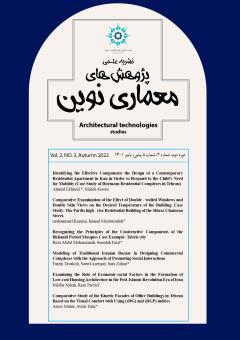A Comparative Study of Kinetic Facades of Office Buildings in Tehran Based on the Visual Comfort with (sDG) and (DGP) indices
Subject Areas :Arezoo Malek 1 , Avideh Talaei 2
1 - PhD student, Department of Architecture, West Tehran Branch, Islamic Azad University, Tehran, Iran.
2 - Assistant Professor, Department of Architecture, West Tehran Branch, Islamic Azad University, Tehran, Iran. (Corresponding Author)
Keywords: Office buildings, Visual comfort, Kinetic facades,
Abstract :
Considering the increase in the trend of using transparent facades in office buildings to use daylight in the space of buildings, creating measures to prevent excessive penetration of sunlight in such spaces and increasing the visual comfort and spatial quality for users and thus improving performance And as a result, reducing energy consumption is essential, so using kinetic facades in this period of time is effective and profitable in order to improve technology and save resources. In Tehran, only a few studies have focused on this subject, and therefore, applicable criteria are needed to meet local preference. In the first step, by studying the types of mobile systems and the way they respond by referring to library documents, and in the next step, modeling the interior and exterior of the samples and analyzes based on their characteristics, This study was carried out with the aim of comparing these facades in terms of visual comfort using index-based evaluation (DGP) in four office spaces located in Tehran, Iran. In conclusion the result of the research is that the kinetic facade with active system and central control had the best performance among all types of systems with a difference of 8.4%.


